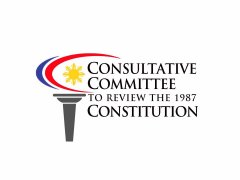
MANILA — The Consultative Committee (ConCom) which drafted the proposed Federal Constitution on Tuesday spelled out the sources of revenues for the federated regions amid questions raised by some of the new draft charter’s critics.
According to ConCom senior technical assistant and spokesperson Ding Generoso, revenues will come from five sources namely (1) regions’ own collection of taxes and fees; (2) share of top revenue sources; (3) share from Equalization Fund; (4) additional funding through the General Appropriations Act; and (5) share of income from natural resources.
Regions’ own taxes, fees
Generoso explained that under Section 2 of Article XIII on Fiscal Powers and Financial Administration, federated regions shall have the power to levy and collect the following taxes, licenses and fees: Real Property Tax; Estate Tax; Donor’s Tax; Documentary Stamp Tax; Professional Tax; Franchise Tax; Games and Amusement Tax; Environmental Tax, Pollution Tax, and similar taxes; Road Users Tax; Vehicle Registration Fees; Transport Franchise Fees; and local taxes and other taxes which may be granted by federal law.
He also allayed fears that giving federated regions taxation powers would result in double taxation, noting that Section 3 of the same article clearly states that “No double taxation shall be allowed.”
“We don’t know how clearer and how more explicit we could get with a provision that says no double taxation should be allowed. If a tax is being collected by the federal government, the same tax can no longer be collected by the federated regions,” Generoso said in a press conference in Pasay City.
“Most of these taxes and fees are now being collected by the national government. What ConCom proposes is simply to transfer the collection of these taxes from the national government to the regional government,” he added.
Share of top revenue sources
Under Section 4 of the same article, Generoso said that the federated regions shall also be given a share of not less than 50 percent of all the revenues from income tax, excise tax, value added tax, and customs duties, which shall be equally divided among them and automatically released.
“What the ConCom proposes is equal share, 50 percent, of the revenue collected from these sources split halfway between the federal government and the federated region and the 50 percent of the federated regions to be divided equally among them,” Generoso said.
Share from equalization fund
Generoso explained that Section 5 of the same article creates an Equalization Fund which shall not be less than three percent of the annual General Appropriations Act (GAA).
“If we compute how much tax and fees will be collected and add with the share in the 50 percent of the top four revenue sources we will see disparities–there are regions with a high total and regions with a low total.
How do we address the deficit of other regions? We go to the Equalization Fund,” Generoso said.
He emphasized that the fund will be distributed based on the need of each region but with priority to those that require support to achieve financial viability and economic sustainability.
The Federal Intergovernmental Commission will be tasked to determine and assess the capabilities of the region and need for it to source from the Equalization Fund, he added.
Additional funding through GAA
Under Section 6 of the same article, Generoso said that regions can also get their revenue from the annual General Appropriations Act (GAA).
“The Congress, through the annual General Appropriations Act, may provide additional finances for the regions to effectively and efficiently deliver government services to their constituents,” the section reads.
Share of income from natural resources
Finally, Section 7 states that federated regions are also entitled to 50 percent of all net revenues derived from the exploration, development, and utilization of all natural resources within their territory.
“Whatever revenue the government will get from the utilization of a particular resource in a region, 50 percent will automatically go to the region and it is up to regional government to distribute it to the constituent units,” Generoso said.
He further said that the most important part of federalism is giving power to the regions to appropriate their funds according to their needs and priorities— and no longer decided by Congress.
“They will have the power to appropriate–whatever their priorities are whatever city, province they want to give a higher share, it’s all up to the legislative assembly of the region and the regional governor. So there’s no dictation from Manila. You don’t have to go to Manila to lobby for appropriation,” Generoso said.
Generoso, meanwhile, stressed anew how taxation is “the most important power of government.”
“Because without taxation, no government will survive. The first power that government must exercise is the power to tax because with taxation then you can have money, resources to do every other thing,” Generoso said.